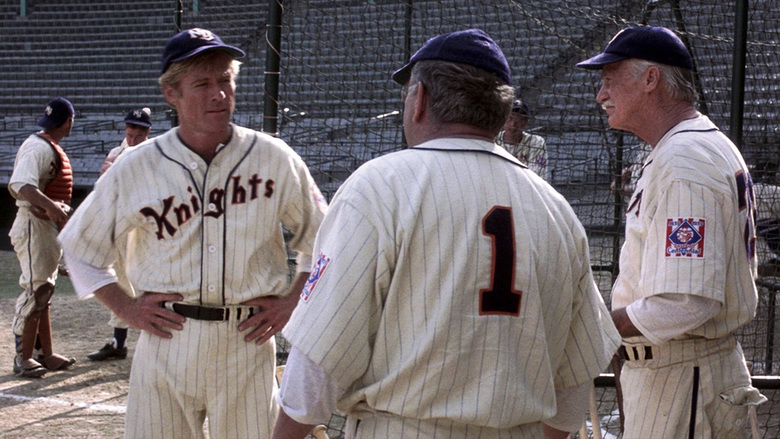“The Natural” is available to stream or rent from Hulu, Prime Video, and most streaming services.
We all love an underdog. Coincidently, the naturally talented baseball player, Roy Hobbs, in Barry Levinson’s 1984 film “The Natural” is exactly that. Played by a young Robert Redford, Roy is a middle-aged “unknown” who comes out of nowhere to become a legendary baseball player with natural talent.
Fiction Imitating Life
While Roy is a fictional character, the story is based on the real-life shooting of All-Star player Edward Waitkus. At the start of his promising career, Ruth Ann Steinhagen, a real-life femme fatale, shot Waitkus in a hotel room. Steinhagen had become obsessed with Waitkus when he debuted for the Chicago Cubs. However, when Waitkus was traded to the Philadelphia Phillies in 1949, Steinhagen became enraged.
Finding out the name of the hotel that Waitkus was staying in, Steinhagen checked in under the alias of one of Waitkus’ high school friends and she left a note with the desk asking him to come to her hotel room. When Waitkus arrived, Steinhagen shot him with a 0.22 calibre gun. The bullet just missed his heart and he survived one of the earliest recognised cases of criminal stalking.
Waitkus’ story is immortalised in Levinson’s film, which is adapted from the 1952 novel of the same name by Bernard Malamud. The story focuses on Roy, who must overcome several points of adversity and injustice (many of them ageist) in the narrative to become the best player there ever was. However, this is a story fraught with failures before huge successes which is a classic reflection of the American Dream ideology. Released in 1984 with a good reception from critics and baseball fans, the film was nominated for four academy awards. It is still hailed as ‘one of the best sports films ever made’ – how characteristic of Roy! Has it aged well?
Context is Important
Always when watching films from 40 + years ago, it is important to note the cultural context of the time. The traditional American baseball aesthetic from the 20th century is incredibly kitschy and male-dominated. This is exactly what “The Natural” is; it is an ’80s film that takes place in the 1930s. Yet the underpinnings of the idealised 20th Century “American Dream” would not stand without these, limiting, narrative angles.

There are several elements of spirituality to this film surrounding Roy’s natural talents. Seeds are sown when the audience learns that Roy learned how to play baseball from his father, who suffers a heart attack under an oak tree. When lightning strikes this same tree, Roy makes his bat from the splintered wood. He burns a lightning bolt and “Wonderboy” onto it. Maybe his talents are supernatural? Regardless though, the audience gets to live out their athletic fantasies vicariously through Roy. As the film closes, things come full circle with Roy playing catch with his son in the same field that he and his father played in.
Women Amidst a Male-Dominated Film
The challenge for Roy is a career slump, which breaks in the infamous scene of the “woman in white” standing like an angel in the stadium crowd. This woman is Glenn Close, playing Iris Gaines, Roy’s major love interest. Aside from just love interests, the film also features its own femme-fatale, Harriet Bird played by Barbara Hershey. Harriet asks Hobbs to come to her hotel room, and after asking him if he really thinks that he is “the best there ever was” she shoots him in stomach. Roy survives, and comes to learn that Harriet has a history of becoming obsessive over athletes. Perhaps one of the most provocative parts of the film, given its direct commentary of the Waitkus shooting as the details are remarkably similar.
While relying on this history, overall, the location shooting of the film gives it a visual authenticity. Most importantly, this is the case with baseball as the audience witnesses old, nostalgic, ball play scenes. These include Buffalo’s War Memorial Stadium and All-High Stadium, as well as Chicago’s Wrigley Field.
How Music Drives ‘The Natural’ and Major League Baseball
Another huge hit for “The Natural” is Randy Newman’s soundtrack. Newman is responsible for a quintessential American sound that borrows stylistic qualities from legendary composers Aaron Copland and Elmer Bernstein. “The Natural” theme, created by Newman, is widely recognisable from the soudrack. If you have not watched the movie yet, you have more than likely heard the theme when baseball stadiums are introducing home teams and their players as a collective. There is a hint to the supernatural even within this theme, as the light flurry of wind instruments come in over the top of the slow, yet regal-sounding trumpets.
Major League Baseball is a musical affair, and music at sporting events has been playing for thousands of years. From walk up tracks, to traditional interval sets, to motivational fan chants. “Ballpark music” started with an organist who debuted at Chicago’s Wrigley Field in 1941 and had spread to most Major League parks by the 1960s. The 1970s saw a move from live organ music to musicians pre-recording pop and rock, “The Natural” is set in the early 1900s—when organ, rock, and pop is missing.
If you’re looking for entertainment to get you in the mindset for the All-Star 2021 game, I recommend “The Natural”. Overall, it is a nostalgic look into classic 20th century American baseball culture, with authentic visual and sonic narratives. Tipping a cap to baseball history, you can watch a film that is fully cognizant of baseball. The ninth inning holds up with the best baseball film ever made.
Citations: Edelman, Rob. “Eddie Waitkus and “The Natural”: What is Assumption? What is Fact?” The National Pastime: From Swampoodle to South Philly (2013); Montgomery, Scott, Gary Norris, and Kevin Walsh. “The Invisible Randy Newman.” Goldmine 21, no. 18. (1995); “Silly Honey.” Time Magazine. June 27, 1949.